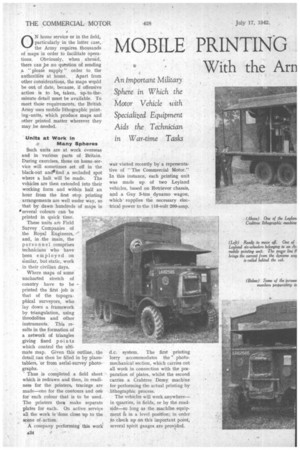MOBILE PRINTING sANTS ON SERVICE
Page 26

Page 27

If you've noticed an error in this article please click here to report it so we can fix it.
With the Am
3 Map Makers An Important Military Sphere in Which the Motor Vehicle with Specialized Equipment Aids the Technician in War-time Tasks
Visit to a Field Survey Company_ Provides Striking Evidence of the invaluable Work Which is Being Done by Map-making Units
0 N home service or in the field, particularly in the latter case, the Army requires thousands of maps in order to facilitate Operations. Obviously, when abroad, there can be no question of sending a " please supply" order to the authorities at home. Apart from other considerations, the maps wonld be out of date, because, if offensive action is to be, taken, up-to-theminute detail must be available. To Meet these requirements, the British Army uses mobile lithographic printing units, which produce maps and other printed matter wherever they may be needed.
Units at Work in Many Spheres
Such units are at work overseas and in variflius parts of Britain. During exercises, those on home-service will sometimes set off in the black-out and.find .a secluded spot
where a halt will be made. The vehicles are then extended into their working form and within half an hour from the first stop printing arrangements are well under way, so that by dawn hundreds of maps in 'several colours can be printed in quick time.
These units are Field Survey Companies of the Royal Engineers, and, in the main, the personnel comprises technicians who have been employed on similar, but static, work in their civilian days.
Where maps of some uncharted stretch of country have to be printed the first job is that of the topographical surveyors, who lay down a framework by triangulation, using theodolites and other instruments. This results in the formation of a network of triangles giving fixed points which control the ultimate map. Given this outline,, the detail can then be ailed in by planetablets, or from aerial-survey photographs.
' Thus is completed a field sheet which is redrawn and then, in readiness for the printers, tracings are made—one for the contours and orfe for each colour that is to be used. The printers thee make separate plates for each. On active service all the work is 'done close up to the scene of.action.
A company performing this work
was visited recently by a representative of "The Commercial Motor." In this instance, each printing unit was made up of two Leyland vehicles, based on Retriever chassis, and a Guy 3-ton, dynamo wagon, whichsupplies the necessary electrical power to the 110-volt 200-amp.
d.c. system. The first printing lorry accommodates the photomechanical section, which carries out all work in connection with the prvparation of plates, whilst the second carries a Crabtree Demy machine for performing the actual printing by lithographic process.
The vehicles will work anywhere-in quarries, in fields, or by the roadside—so long as the machine equipment is ina• level position; in order to check up on this important point, several spirit gauges are provided.
The Guy vehicle also serves for carrying spares and equipmentrwhen the unit is moving from place to place. These vehicles are supplemented by a 30-cwt. Bedford for collecting the company's stores and food; also a nibtorcycle for general duties, including the collection and despatch of small quantities of printed matter.
A lithographic plate, such as that already mentioned, will be prepared in the first of the Leyland lorries, and, after the actual making, it is touched up by litho-artists, being then passed to the provers, who prepare it for the machine. All the variety of apparatus needed in preparing the plates is packed neatly into carefully arranged cabinets, cupboards, and welts, which are fitted up in the first vehicle ia such a
manner as to ensure the utmost economy of space. Below the floor are housed two tanks, which provide sufficient water for a week or even a fortnight's work.
About 200 of the zinc plates used in connectisn with the lithographic process are always carried. These form a constant stock,. because after the completion of a job a plate is usually cleaned and grained ready for re-use, but in some cases where further supplies of certain printed • matter are likely to be required, the finished Plates are kept in stock in readiness for future operations. Where there is less likelihood of a repeat order the map or other material for reproauction is kept in the form of tracing-paper prints, or on a Kodaline negative.
3,500 Impressions
Per Hour Obtained In the second vehicle the machine.
equipment runs just as it would in a normal press-roorn arid the machine man prints the job, superimposing all the colours that may be neces.sa,ry to show the different topographical features of the countryside. The normal running speed of the machine that we inspected is 3,500 impressions per hour, so that large numbers of maps or diagrams can quickly be supplied.
In the case of the
particular unit we visited, the bulk of the work is in connection with diagrams or maps drawn on tracing. or cartridge paper. These are positives and the process used for reproducing them is gum reversal.
Considerable numbers of maps of various places in the Command are often required, and these . are generally reproduced on a scale of 1-to-25,000. For this purpose a Kodaline negative is used; this is a special film felt making line negatives of maps. These negatives are made by the Ordnance Survey and a complete set for the Command is sent to and held by the Survey Company _ (Reproduction Section). The method used for reproduction in tTns instance is the Hello process. Thus, in yet another way, does the transport vehicle aid technicians 'in the accomplishment of a variety of important specialiied tasks associated with war-time conditions.




















































